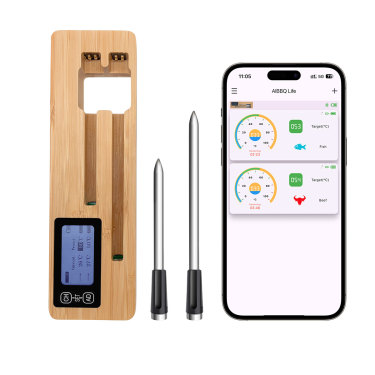
# Digital Meat Thermometer Guide
## Introduction to Digital Meat Thermometers
A digital meat thermometer is an essential tool for any home cook or professional chef. Unlike traditional analog thermometers, digital versions provide quick and accurate temperature readings, ensuring your meat is cooked to perfection every time. Whether you’re grilling, roasting, or smoking, a digital meat thermometer can help you achieve the desired level of doneness while maintaining food safety.
## Why Use a Digital Meat Thermometer?
Keyword: digital meat thermometer
Using a digital meat thermometer offers several advantages:
– **Accuracy**: Digital thermometers provide precise temperature readings, often within 1-2 degrees Fahrenheit.
– **Speed**: Most digital thermometers deliver readings in seconds, reducing the time your oven or grill is open.
– **Ease of Use**: Clear digital displays make it simple to read temperatures, even in low-light conditions.
– **Versatility**: Many models can be used for various types of meat, as well as other foods like baked goods or candy.
## Types of Digital Meat Thermometers
There are several types of digital meat thermometers available, each suited for different cooking methods:
### 1. Instant-Read Thermometers
These thermometers provide quick temperature readings and are ideal for checking the doneness of meat during cooking. They are not designed to stay in the oven or grill during the cooking process.
### 2. Leave-In Thermometers
Leave-in thermometers are designed to remain in the meat while it cooks. They often come with a probe that connects to a display unit outside the oven or grill, allowing you to monitor temperatures without opening the door.
### 3. Wireless Thermometers
Wireless models use Bluetooth or Wi-Fi to send temperature data to your smartphone or a dedicated receiver. These are perfect for monitoring meat from a distance, such as when smoking or slow-cooking.
### 4. Oven-Safe Thermometers
These thermometers can withstand high temperatures and are designed to stay in the meat while it cooks in the oven. They typically have a dial or digital display that can be read through the oven door.
## How to Use a Digital Meat Thermometer
Using a digital meat thermometer correctly is crucial for accurate results. Follow these steps:
1. **Insert the Probe**: Place the probe into the thickest part of the meat, avoiding bones, fat, or gristle.
2. **Wait for the Reading**: For instant-read thermometers, wait a few seconds until the temperature stabilizes. For leave-in models, monitor the display as the meat cooks.
3. **Check Multiple Spots**: For larger cuts of meat, check the temperature in several places to ensure even cooking.
4. **Clean the Thermometer**: Always clean the probe with warm, soapy water after use to prevent cross-contamination.
## Recommended Internal Temperatures for Meat
To ensure food safety and optimal taste, cook meat to the following internal temperatures:
– **Beef, Lamb, and Veal (Medium-Rare)**: 145°F (63°C)
– **Beef, Lamb, and Veal (Medium)**: 160°F (71°C)
– **Poultry (Chicken, Turkey)**: 165°F (74°C)
– **Pork**: 145°F (63°C)
– **Fish**: 145°F (63°C)
## Tips for Choosing the Best Digital Meat Thermometer
When selecting a digital meat thermometer, consider the following factors:
– **Temperature Range**: Ensure the thermometer covers the range needed for your cooking methods.
– **Response Time**: Faster response times are more convenient, especially for grilling.
– **Durability**: Look for models with sturdy probes and water-resistant designs.
– **Ease of Cleaning**: Removable probes or dishwasher-safe components make cleaning easier.
– **Additional Features**: Some thermometers offer preset temperature alarms, backlit displays, or smartphone connectivity.
## Conclusion
A digital meat